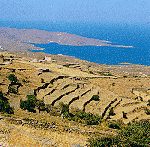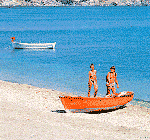The small island of Kythnos is mainly mountainous but full of pretty little bays which relieve the harshenees of the bare earth. Hora or Messaria is the island's capital noted for the beautiful churches with their fine wood-carving, sanctuary screens and icons. According to tradition, the island was named after Kithnos, the leader of the Driopes, its first settlers. It was also called Driopis at that time. Driopes settled the island around the 12th-11th century BC. During classical times, they founded such a perfectly organised autonomous state that Aristotel mentioned it in his "About the Kithnians' State", which has not been preserved. Like the rest of the Cyclades, Kithnos joined the Athenian League and was subjugated by the Macedonians, Ptolemies and Romans, who used it as an exile. During Byzantine times, it belonged to the Theme of the Aegean. After the fall of Constantinople, it was conquered by Marco Sanudo and was ruled by Venetian families. In 1617, the Turks placed the island under the jurisdiction of the Sultan, ousting the last Venetian ruler, Angelo Gozadino. All through the Turkish domination, the island was scourged by pirate raids and epidemics alike. In 1823, plague decimated the island's inhabitants. "Kithniaka" is another bloody page of the island's history. In February of 1862, rebels from Siros who attempted to liberate the exiles clashed with the army at Agia Anna Bay. They were violently defeated and only after the Otto's dethronement, their bones were transferred to the 1st Cemetery of Athens. Interesting sightseeing sites are:
According to tradition, the island was named after Kithnos, the leader of the Driopes, its first settlers. It was also called Driopis at that time. Driopes settled the island around the 12th-11th century BC. During classical times, they founded such a perfectly organised autonomous state that Aristotel mentioned it in his "About the Kithnians' State", which has not been preserved. Like the rest of the Cyclades, Kithnos joined the Athenian League and was subjugated by the Macedonians, Ptolemies and Romans, who used it as an exile. During Byzantine times, it belonged to the Theme of the Aegean. After the fall of Constantinople, it was conquered by Marco Sanudo and was ruled by Venetian families. In 1617, the Turks placed the island under the jurisdiction of the Sultan, ousting the last Venetian ruler, Angelo Gozadino. All through the Turkish domination, the island was scourged by pirate raids and epidemics alike. In 1823, plague decimated the island's inhabitants. "Kithniaka" is another bloody page of the island's history. In February of 1862, rebels from Siros who attempted to liberate the exiles clashed with the army at Agia Anna Bay. They were violently defeated and only after the Otto's dethronement, their bones were transferred to the 1st Cemetery of Athens. Interesting sightseeing sites are:
 The Church of Panagia Flambouriani stands in the village of Flambouria, south-west of the town of Kithnos. According to tradition, there are traces from the steps of the Virgin all the way from the beach to the church. In summer, lilies in bloom in the area give off their sweet smell. The beautiful post-Byzantine church of Agia Triada is situated in Kithnos (Hora). Built in basilica with a dome style, Agia Triada is the oldest church on the island. It took its present shape after a series of restorations and continuous changes, and it hardly reminds one of the first church. In the interior, remarkable frescoes are well preserved, as well as icons of the post-Byzantine period. Ancient sculptures and inscriptions have been found in the area around the church. The monastery of Panagia Kanala stands in a lovely area, 16 km south-east of Kithnos, near the village of Kanala. Inside it, one can admire the miraculous icon of the Virgin. It is supposed to have been found in the area of Kanali and, according to tradition, is a work of Luke the Evangelist. According to the scholars, however, it is the work of the folk artist, Antonis Skordilis and dates, back to the 15th century. On its feast days, on the 15th of August and 8th of September, big festivals are held, attracting pilgrims from all over the island. The monastery of Panagia Nikous dominates over Hora. From all its constructions, only its three-aisled basilica church with the two domes still stands. During the Turkish domination, a "secret school" was functioning in the monastery's basement.
The Church of Panagia Flambouriani stands in the village of Flambouria, south-west of the town of Kithnos. According to tradition, there are traces from the steps of the Virgin all the way from the beach to the church. In summer, lilies in bloom in the area give off their sweet smell. The beautiful post-Byzantine church of Agia Triada is situated in Kithnos (Hora). Built in basilica with a dome style, Agia Triada is the oldest church on the island. It took its present shape after a series of restorations and continuous changes, and it hardly reminds one of the first church. In the interior, remarkable frescoes are well preserved, as well as icons of the post-Byzantine period. Ancient sculptures and inscriptions have been found in the area around the church. The monastery of Panagia Kanala stands in a lovely area, 16 km south-east of Kithnos, near the village of Kanala. Inside it, one can admire the miraculous icon of the Virgin. It is supposed to have been found in the area of Kanali and, according to tradition, is a work of Luke the Evangelist. According to the scholars, however, it is the work of the folk artist, Antonis Skordilis and dates, back to the 15th century. On its feast days, on the 15th of August and 8th of September, big festivals are held, attracting pilgrims from all over the island. The monastery of Panagia Nikous dominates over Hora. From all its constructions, only its three-aisled basilica church with the two domes still stands. During the Turkish domination, a "secret school" was functioning in the monastery's basement.
 According to tradition, the island was named after Kithnos, the leader of the Driopes, its first settlers. It was also called Driopis at that time. Driopes settled the island around the 12th-11th century BC. During classical times, they founded such a perfectly organised autonomous state that Aristotel mentioned it in his "About the Kithnians' State", which has not been preserved. Like the rest of the Cyclades, Kithnos joined the Athenian League and was subjugated by the Macedonians, Ptolemies and Romans, who used it as an exile. During Byzantine times, it belonged to the Theme of the Aegean. After the fall of Constantinople, it was conquered by Marco Sanudo and was ruled by Venetian families. In 1617, the Turks placed the island under the jurisdiction of the Sultan, ousting the last Venetian ruler, Angelo Gozadino. All through the Turkish domination, the island was scourged by pirate raids and epidemics alike. In 1823, plague decimated the island's inhabitants. "Kithniaka" is another bloody page of the island's history. In February of 1862, rebels from Siros who attempted to liberate the exiles clashed with the army at Agia Anna Bay. They were violently defeated and only after the Otto's dethronement, their bones were transferred to the 1st Cemetery of Athens. Interesting sightseeing sites are:
According to tradition, the island was named after Kithnos, the leader of the Driopes, its first settlers. It was also called Driopis at that time. Driopes settled the island around the 12th-11th century BC. During classical times, they founded such a perfectly organised autonomous state that Aristotel mentioned it in his "About the Kithnians' State", which has not been preserved. Like the rest of the Cyclades, Kithnos joined the Athenian League and was subjugated by the Macedonians, Ptolemies and Romans, who used it as an exile. During Byzantine times, it belonged to the Theme of the Aegean. After the fall of Constantinople, it was conquered by Marco Sanudo and was ruled by Venetian families. In 1617, the Turks placed the island under the jurisdiction of the Sultan, ousting the last Venetian ruler, Angelo Gozadino. All through the Turkish domination, the island was scourged by pirate raids and epidemics alike. In 1823, plague decimated the island's inhabitants. "Kithniaka" is another bloody page of the island's history. In February of 1862, rebels from Siros who attempted to liberate the exiles clashed with the army at Agia Anna Bay. They were violently defeated and only after the Otto's dethronement, their bones were transferred to the 1st Cemetery of Athens. Interesting sightseeing sites are: The Church of Panagia Flambouriani stands in the village of Flambouria, south-west of the town of Kithnos. According to tradition, there are traces from the steps of the Virgin all the way from the beach to the church. In summer, lilies in bloom in the area give off their sweet smell. The beautiful post-Byzantine church of Agia Triada is situated in Kithnos (Hora). Built in basilica with a dome style, Agia Triada is the oldest church on the island. It took its present shape after a series of restorations and continuous changes, and it hardly reminds one of the first church. In the interior, remarkable frescoes are well preserved, as well as icons of the post-Byzantine period. Ancient sculptures and inscriptions have been found in the area around the church. The monastery of Panagia Kanala stands in a lovely area, 16 km south-east of Kithnos, near the village of Kanala. Inside it, one can admire the miraculous icon of the Virgin. It is supposed to have been found in the area of Kanali and, according to tradition, is a work of Luke the Evangelist. According to the scholars, however, it is the work of the folk artist, Antonis Skordilis and dates, back to the 15th century. On its feast days, on the 15th of August and 8th of September, big festivals are held, attracting pilgrims from all over the island. The monastery of Panagia Nikous dominates over Hora. From all its constructions, only its three-aisled basilica church with the two domes still stands. During the Turkish domination, a "secret school" was functioning in the monastery's basement.
The Church of Panagia Flambouriani stands in the village of Flambouria, south-west of the town of Kithnos. According to tradition, there are traces from the steps of the Virgin all the way from the beach to the church. In summer, lilies in bloom in the area give off their sweet smell. The beautiful post-Byzantine church of Agia Triada is situated in Kithnos (Hora). Built in basilica with a dome style, Agia Triada is the oldest church on the island. It took its present shape after a series of restorations and continuous changes, and it hardly reminds one of the first church. In the interior, remarkable frescoes are well preserved, as well as icons of the post-Byzantine period. Ancient sculptures and inscriptions have been found in the area around the church. The monastery of Panagia Kanala stands in a lovely area, 16 km south-east of Kithnos, near the village of Kanala. Inside it, one can admire the miraculous icon of the Virgin. It is supposed to have been found in the area of Kanali and, according to tradition, is a work of Luke the Evangelist. According to the scholars, however, it is the work of the folk artist, Antonis Skordilis and dates, back to the 15th century. On its feast days, on the 15th of August and 8th of September, big festivals are held, attracting pilgrims from all over the island. The monastery of Panagia Nikous dominates over Hora. From all its constructions, only its three-aisled basilica church with the two domes still stands. During the Turkish domination, a "secret school" was functioning in the monastery's basement. 
